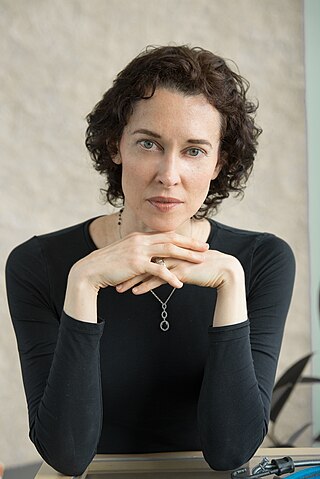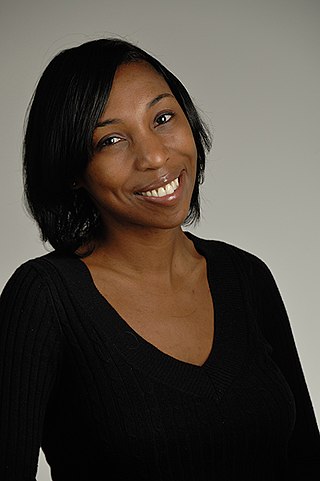Related Research Articles

The lymphatic system, or lymphoid system, is an organ system in vertebrates that is part of the immune system, and complementary to the circulatory system. It consists of a large network of lymphatic vessels, lymph nodes, lymphoid organs, lymphatic tissue and lymph. Lymph is a clear fluid carried by the lymphatic vessels back to the heart for re-circulation. The Latin word for lymph, lympha, refers to the deity of fresh water, "Lympha".

Sangeeta N. Bhatia is an American biological engineer and the John J. and Dorothy Wilson Professor at MIT’s Institute for Medical Engineering and Science and Electrical Engineering and Computer Science (EECS) at the Massachusetts Institute of Technology (MIT) in Cambridge, Massachusetts, United States. Bhatia's research investigates applications of micro- and nano-technology for tissue repair and regeneration. She applies ideas from computer technology and engineering to the design of miniaturized biomedical tools for the study and treatment of diseases, in particular liver disease, hepatitis, malaria and cancer.
J. Brandon Dixon is a professor of mechanical and biomedical engineering at the Georgia Institute of Technology. He heads the Laboratory of Lymphatic Biology and Bioengineering (LLBB). Among his most recent publications, Dr. Dixon developed a tissue engineered in vitro model to recapitulate lipid uptake by intestinal lymphatics.
Kristi S. Anseth is the Tisone Distinguished Professor of Chemical and Biological Engineering, an Associate Professor of Surgery, and a Howard Hughes Medical Investigator at the University of Colorado at Boulder. Her main research interests are the design of synthetic biomaterials using hydrogels, tissue engineering, and regenerative medicine.

Donald E. Ingber is an American cell biologist and bioengineer. He is the founding director of the Wyss Institute for Biologically Inspired Engineering at Harvard University, the Judah Folkman Professor of Vascular Biology at Harvard Medical School and Boston Children's Hospital, and Professor of Bioengineering at the Harvard John A. Paulson School of Engineering and Applied Sciences. He is also a member of the American Institute for Medical and Biological Engineering, the National Academy of Engineering, the National Academy of Medicine, the National Academy of Inventors, and the American Academy of Arts and Sciences.

Rashid Bashir is Dean of The Grainger College of Engineering, Grainger Distinguished Chair in Engineering and Professor of Bioengineering, at the University of Illinois at Urbana-Champaign. He was the Executive Associate Dean and Chief Diversity Officer at the Carle-Illinois College of Medicine at UIUC. Previously, he was the Abel Bliss Professor of Engineering.
Maryellen L. Giger, is an American physicist and radiologist who has made significant contributions to the field of medical imaging.

Jennifer Hartt Elisseeff is an American biomedical engineer, ophthalmologist and academic. She is the Morton Goldberg Professor and Director of the Translational Tissue Engineering Center at Johns Hopkins Department of Biomedical Engineering and the Wilmer Eye Institute with appointments in Chemical Engineering, Biomedical Engineering, Materials Science and Orthopedic Surgery. Elisseeff's research is in the fields of regenerative medicine and immunoengineering.
Laura Elizabeth Niklason is a physician, professor and internationally recognized researcher in vascular and lung tissue engineering. She is the Nicholas M. Greene Professor of Anesthesiology and Biomedical Engineering at Yale University and co-founder, chief executive officer and president of Humacyte, a regenerative medicine company developing bioengineered human tissues.
Viola Vogel, also known as Viola Vogel-Scheidemann, is a German biophysicist and bioengineer. She is a professor at ETH Zürich, where she is head of the Department of Health Sciences and Technology and leads the Applied Mechanobiology Laboratory.
Caitríona Lally is a professor of Bioengineering in Trinity College, Dublin. She has been a qualified mechanical engineer since 1997. She did a PhD in cardiovascular biomechanics.
Miram Merad is a French-Algerian professor in Cancer immunology and the Director of the Marc and Jennifer Lipschultz Precision Immunology Institute (PrIISM) at the Icahn School of Medicine at Mount Sinai (ISMMS) in New York, NY. She is the corecipient of the 2018 William B. Coley Award for Distinguished Research in Basic Immunology and a member of the United States National Academy of Sciences and the National Academy of Medicine.
Susmita Bose is an Indian-American scientist and engineer, best known for her research on biomaterials, 3D printing or additive manufacturing of bone implants and natural medicine. She is the Herman and Brita Lindholm Endowed Chair Professor in the School of Mechanical and Materials Engineering at Washington State University.

Kandice Tanner is a Trinidad and Tobago biophysicist researching the metastatic traits that allow tumor cells to colonize secondary organs. She is a Senior Investigator at the National Cancer Institute, where she is head of the Tissue morphodynamics section.
Jennifer L. West is an American bioengineer. She is the current Dean of Engineering and Applied Science at the University of Virginia. She was the Fitzpatrick University Professor of Biomedical Engineering at Duke University from 2012-2021. In 2000, West cofounded Nanospectra Biosciences in Houston to develop a cancer therapy based on gold nanoparticles that destroy tumor cells and has been listed by MIT Technology Review as one of the 100 most innovative young scientists and engineers world wide.

Gwendalyn J. Randolph is an American immunologist, the Emil R. Unanue Distinguished Professor in the Department of Immunology and Pathology at Washington University School of Medicine where she is currently co-director of the Immunology Graduate Program. During her postdoctoral work, Randolph characterized monocyte differentiation to dendritic cells and macrophages and made advances in our understanding of dendritic cell trafficking and the fate of monocytes recruited to sites of inflammation. Her lab has contributed to the Immunological Genome Project by characterizing macrophage gene expression. Her work now focuses on the immunological mechanisms driving atherosclerosis and inflammatory bowel disease (IBD) by exploring lymphatic function and lipoprotein trafficking.
Beth L. Pruitt is an American engineer. Upon completing her master's degree in manufacturing systems engineering from Stanford University, Pruitt served as an officer in the United States Navy. She is a full professor of mechanical engineering, biological engineering, and biomolecular science & engineering at the University of California, Santa Barbara. She is a fellow of both ASME and AIMBE.
Adekunle O. Odunsi is an American gynecologic oncologist. In 2021, Odunsi became the director of the University of Chicago Comprehensive Cancer Center.
Jeffrey Alan Hubbell is an American molecular engineer. During his early career, Hubbell founded three companies based on his academic research and was the holder of 88 U.S. patents.

Stacey Finley is the Nichole A. and Thuan Q. Pham Professor and associate professor of chemical engineering and materials science, and quantitative and computational biology at the University of Southern California. Finley has a joint appointment in the department of chemical engineering and materials science, and she is a member of the USC Norris Comprehensive Cancer Center. Finley is also a standing member of the MABS Study Section at NIH. Her research has been supported by grants from the NSF, NIH, and American Cancer Society.
References
- 1 2 3 "Melody Swartz". pme.uchicago.edu. Retrieved 2024-03-20.
- 1 2 Griffith, Linda G.; Swartz, Melody A. (March 2006). "Capturing complex 3D tissue physiology in vitro". Nature Reviews Molecular Cell Biology. 7 (3): 211–224. doi:10.1038/nrm1858. ISSN 1471-0080. PMID 16496023.
- 1 2 "National Academy of Engineering Elects 106 Members and 18 International Members". NAE Website. Retrieved 2024-03-20.
- 1 2 "Dr. Melody A. Swartz". NAE. Retrieved 2024-03-20.
- 1 2 "Melody Swartz elected to the Royal Academy of Medicine of Belgium". ciic.uchicago.edu. 2023-02-07. Retrieved 2024-03-20.
- 1 2 "Melody Swartz elected to the National Academy of Medicine". pme.uchicago.edu. 2020-10-19. Retrieved 2024-03-20.
- 1 2 "The Faculty". biophysics.uchicago.edu. Retrieved 2024-03-20.
- ↑ "Faculty and Trainers". immunology.uchicago.edu. Retrieved 2024-03-20.
- ↑ "Faculty & Trainers". cancerbio.uchicago.edu. Retrieved 2024-03-20.
- ↑ "Scientific Advisory Board". ki.mit.edu. Retrieved 2024-03-20.
- ↑ "Prof Melody Swartz". BRCCH. Retrieved 2024-03-20.
- ↑ "Angiogenesis". SpringerLink. Retrieved 2024-03-20.
- ↑ "Editors". aacrjournals.org. Retrieved 2024-03-20.
- ↑ "Biomechanics and Modeling in Mechanobiology". SpringerLink. Retrieved 2024-03-20.
- ↑ "Melody Ann Swartz". www.amacad.org. 2024-02-09. Retrieved 2024-03-20.
- ↑ "Melody Swartz". www.macfound.org. Retrieved 2024-03-20.